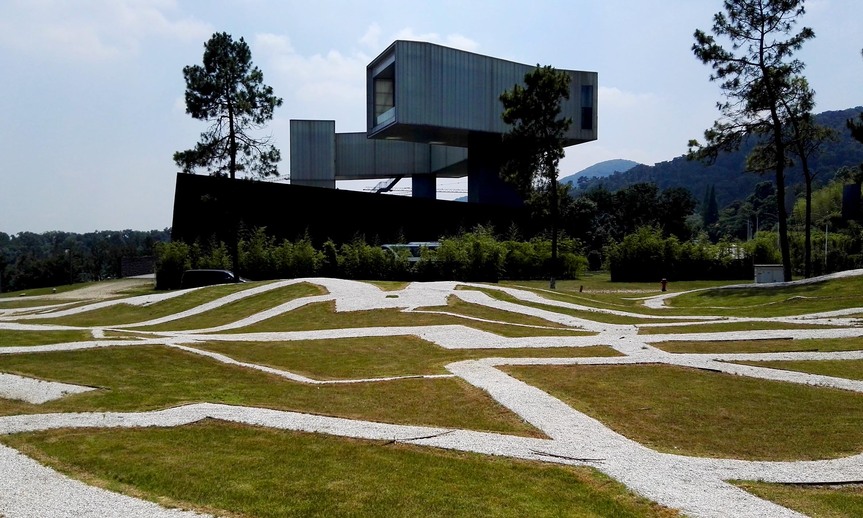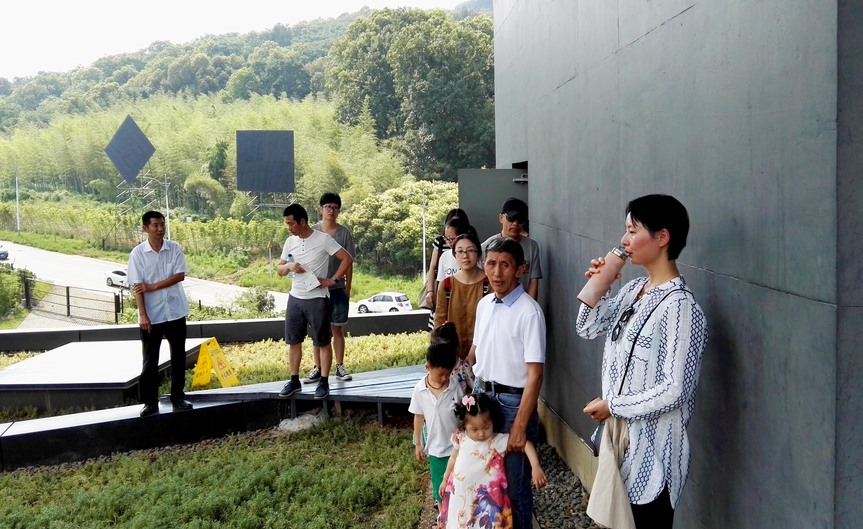
R
E
V N
E
X
T
Set in a verdant woodland are a group of luxury villas surrounding a lake that appear like architectural jewels scattered around the water. Standing in contrast to these villas is the strange form of the five-year-old Sifang Art Museum, designed by Steven Holl, an apparent alien presence overlooking the scene. In this contemporary paradise it is hard to imagine the lifestyles of people dwelling in these elite houses. Visiting the site, and getting up close, allows one to experience the tussle between altruistic philanthropy (and a vision where futuristic design is in harmony with nature); the fact that property development is being carved out of virgin soil; and the tension between dream and reality.
This idyllic museum complex, originally conceived in 2003 by father and son collectors Lu Jun and Lu Xun, whose fortunes were built in real-estate development, is still under construction. The villas, which will eventually number 20, are projected, somewhat optimistically, for completion next year. This “settlement” is the manifestation of the Chinese International Practical Exhibition of Architecture, a permanent exhibition of environmentally conscious architecture. At Sifang, rather than wilderness the backdrop to the lake is new housing: an elite compound spreading up into the hills, where the sales office is installed in one of the villas named Pond Lily House (2012), designed by Chilean architect Mathias Klotz. This topography is rich with paradoxes: accessible isolation and decaying development. Several of the extravagant buildings seem to be becoming derelict in advance of completion, showing crumbling, rusted steel and rotting wood. When this reviewer visited in June, the lawns were being aggressively treated with chemicals, and carefully manicured regions were degenerating at the parameters, exposing rubble and detritus.
More trouble in this paradise was exposed through the current exhibition, “Mountain Sights: Views of Laoshan,” which derived from artists’ residencies that appeared to be ongoing. When viewing the show, some of the artists were seen camping out in the villas, messing up the immaculate interior design with art materials, discarded clothes and cooking debris. Only a handful of works were found in and around the Sifang Museum itself—the exhibition spreads well beyond its precincts across a larger scenic area of 20 or so kilometers.
“Mountain Sights: Views of Laoshan” demands a leisurely day trip. Not so much “site” as “sight” specific, the art reflects on the imprint of tourists, with the exhibition title specifically referring to the visitors’ views. The exhibited works are gentle, in most cases resisting intrusion in deference to the existing environment. Wang Wei, for instance, lays a neat flat tiled floor among the rubble of a disused quarry; the artist group L Sub have created sequences of stories developed in partnership with local school children, the narratives inspired by sightseers’ discarded drink cans that the artists witnessed being tossed thoughtlessly into a dark grotto. The work consists of a folder of these stories, a neat pile of empty drink cans marked with gold paint, a large photographic image of people lurking at the entrance to a cave, and a “field recording” of the clatter of cans in the environmental ambience.
In most cases there is little to see, so it is only a wandering visitor passing through who can experience these works. Some pieces just look at the tourists themselves: in the case of Liang Yue’s 16-screen suite of videos, Somewhere or Others in the Mountain (2016), tourists are observed bringing kayaks to the water or modernist furniture into their holiday homes, or we are shown scenes of nice looking places just waiting to be looked observed Zheng Bo’s garden of weeds on the roof of the museum suggests that the wrong visitors can compromise the purity of the garden.
As a whole the exhibition seems designed to encourage visitors to come into contact with features of the site that might otherwise be overlooked. From this point of view, “Mountain Sights” is a marriage of interests, providing opportunities for artists to commune temporarily with a changing natural landscape, while encouraging visitors to see the attributes of a beautiful place where plots are still available.
“Mountain Sites: Views of Laoshan” is on view at Sifang Art Museum, Nanjing, until October 5, 2016.




